 Written by Megan Smith, PT
Written by Megan Smith, PT
Avoid becoming just another slip and fall statistic by using a walking cane for mobility support. As the most commonly used assistive mobility device, walking canes reduce the risk of falling and improve balance. When they’re sized and used correctly, a cane for walking widens the base of support, decreasing the amount of weight that’s distributed on the feet, ankles, knees, and hips. Whether it’s intended for temporary or permanent mobility support, there’s no doubt that a walking cane can provide an easy-to-use option for seniors aging in place at home and adults of any age who need some walking support. In this article, our product experts help you find the best walking cane to meet your unique requirements, sorting through the many styles and options so you can choose the most suitable support.
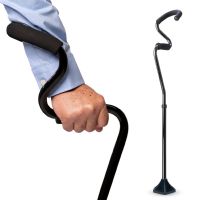 | StrongArm Comfort Cane - Self Standing Support View Product |
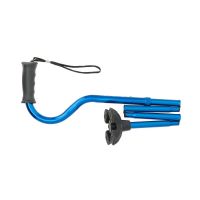 | Quad-Cane Hybrid Folding Cane by Medline View Product |
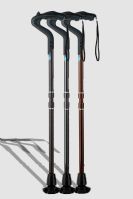 | Ergoactives Ergocane 2G with Ergonomic Grip Handle View Product |
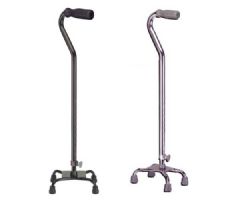 | Drive Medical Height Adjustable Small Base Quad Canes View Product |
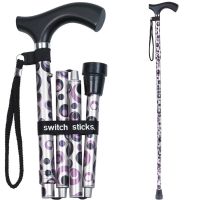 | Mabis Fashion Cane - Switch Sticks Foldable Ladies Walking Canes View Product |
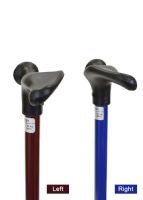 | Palm Grip Handle Walking Cane by Walk Easy View Product |
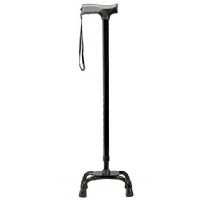 | Carex Soft Grip Quad Cane View Product |
 | Bariatric Steel Black Quad Cane by Medline 500 lbs View Product |
Crafted in a variety of designs, cane handles can greatly optimize user comfort when the right type is chosen. Modeled after the traditional shepherd’s crook, rounded cane handles, also known as C-cane handles or tourist handles, are the most common configuration, offering modest comfort along with the convenience of hooking the cane over the user’s arm when it’s not in active use. Function-grip or T-handle cane handles are well-suited for users living with hand weakness or fatigue, while the similarly designed Fritz handles highlight an extra curve to reduce pressure on the hands and fingers, making it a great choice for arthritis sufferers.
Derby handles and similarly styled ergonomic handles improve the user/equipment interface, helping to optimize efficiency, safety, and comfort, especially for users with carpal tunnel, arthritis, and other kinds of hand, wrist, and forearm conditions. Palm grip cane handles or orthopedic handles are specially configured for either the right or left hand, providing a custom-like fit for the palm of your hand. Offset cane handles are shaped like a question mark to promote even weight distribution over the body of the cane, maximizing stability and balancing support. Foam and/or gel grips further reduce pain and fatigue, enhancing user comfort.
Cane shafts and bases come in a variety of designs providing varying levels of stability, support, and mobility assistance. Generally constructed to be lightweight, canes may be made with aluminum, steel tubing, carbon fiber, and other strong but lightweight materials. They may also be coated with a protective finish to extend durability. Shafts can be configured as straight poles, or angled to offset the user’s weight. Some models are conveniently foldable for small, compact portability. Bases include a single standard tip, a single pivoting tip, a 3-point tip, and a 4-point tip. Rubberized tips are typically the best option for optimal traction, while specialized tips, such as those designed for snow and ice are helpful for different situations as well.
Compact, sleek, and easy to maneuver, the single standard tip is the most common cane design. Pivoting tips are designed with a circular indentation near the tip’s bottom, providing greater stability as it enables the cane to pivot backward and forward without losing traction. For users who are more unsteady, 3-point or tripod cane bases and 4-point or quad cane bases deliver maximum stability and balancing support. They also stand upright on their own, preventing users from having to bend and reach the floor if their cane has fallen.
To ensure proper support from a cane, it’s important to take some measurements. Stand up straight with your arms hanging straight at your sides and measure from the crease of the wrist to the floor to determine the best cane length. The elbow should bend at about a 15-degree angle when the cane is in your hand, although more of a bend may be necessary for people who are primarily using the cane for balance. When a walking cane is too short, it may cause side leaning, which can impair balance. If it’s too long, it will make the user work harder to pick it up and move it, resulting in fatigue. Most quality canes are height-adjustable to ensure the perfect fit for every user.
Crucial for safety and secure support, be sure to choose a cane that can easily support your weight. Cane designs can vary in the weight capacities they accommodate. If the user weighs more than what the walking cane can support, it may buckle, break, or fold, potentially causing injury. If the intended user’s weight falls on the maximum end of the cane’s capacity, it’s best to choose the next size up. Bariatric walking canes offer much higher weight capacities, making them the best choice for larger, heavier, users.
As a highly valuable tool that adds stability and balance support, a cane for walking may be beneficial for adults of any age who are living with either temporary or permanent mobility impairments. While it may be difficult to decide when it’s time for a cane, there are certain conditions that people can experience that are indicative of requiring this walking assistance:
A: Medicare Part B medical insurance covers walking canes as DME (durable medical equipment). A healthcare professional must prescribe the equipment and be enrolled in Medicare for it to be paid for by Medicare. Rehabmart can supply you with the HCPCS (Healthcare Common Procedure Coding System) codes you need to file your Medicare claim.
A: You use a walking cane on the side of the body that is uninjured or less affected. For walking support, set the cane about one stride ahead and step off on the injured leg, finishing the step with the good leg. To climb stairs, grasp the handrail with your free hand and step up with the good leg first, followed by a step up with the injured leg. To walk down the stairs, put the cane on the step first, followed by the injured leg, and then the good leg.
A: Although a cane for walking may not help with every kind of back pain, it can be exceptionally effective for back pain that’s related to the hips and legs, such as sciatica or hip replacement surgery. Back pain that is caused by a poor walking gait can improve with the use of a walking cane as well. Canes also help people stay active and mobile without putting too much weight or pressure on the back, preventing and relieving stiff muscles and joints.
A: A walking cane helps to prevent falls when it is used and sized correctly. People need to be trained on the safe use and correct ways to utilize the cane for walking and navigating stairs to prevent slips, falls, and other injuries. The cane also needs to be the correct height for the user. The best way that canes prevent falls is to use them - studies show that among people who fall at home, 75 percent of them were not using their cane or walker when they fell.
A: To buy a walking cane that’s right for you and your unique needs, be sure to talk to your doctor about what kind of mobility support is best. It’s important to measure your wrist crease to the floor while standing to determine the best height for you, along with figuring out how much balance and stability support you require to determine the best base. We suggest reading this Caregiver University article that covers in-depth tips for how to choose the best walking cane to meet your needs.
A: Unlike a standard one-tip cane, a quad cane has a base with four small feet that are typically capped with rubber. Offering more stability than a single cane, a quad cane is often utilized following illness, injury, or surgery. It’s a good choice for users with more involved mobility issues and those with two weak or affected legs.
A: You do not need a prescription for a walking cane unless you want to have it paid for by Medicare, Medicaid, or some other type of health insurance.
Learning how to properly size and use a walking cane can help the elderly and adults of all ages living with mild to moderate mobility impairments. Preventing falls, slipping, and other injuries, a cane for walking optimizes balance and stability, helping to redistribute the user’s weight and lighten the load on the joints and muscles of the lower body.
Walking canes are available in a wide variety of styles and sizes, offering different levels of support. It’s important to choose the right kind to fit your unique needs, along with safely accommodating your height and weight. Various handle types and base styles enable you to find the exact support you need for safe walking and a comfortable grip.
Thanks for reading, and we invite you to check out more caregiving tips and to learn more about tools for the job of living at Caregiver University.

Megan has been a part of Rehabmart since its inception nearly 20 years ago. For the past several years she has been enjoying her role as HR Director while maintaining her Physical Therapy license. When she isn't working on her next in-service or working to find a new team member, she enjoys her five children, helping those who have PT type ailments, baking, practicing yoga, and working out.